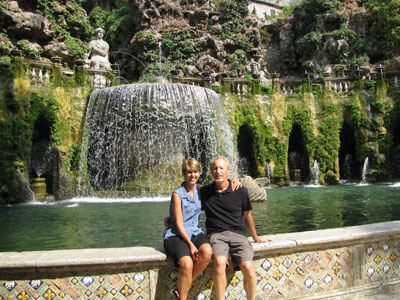Tivoli’s Villa d’Este
On our way to a week in Umbria in September ’09, my husband, two friends and I debated descriptions of the various villas along the tourist trail and decided on a visit to the Villa d’Este (Piazza Trento, 5) in Tivoli, ground central for villas.
We made our way to the center of the city and discovered that we were practically at the doorstep of Villa d’Este. (Entry, €10 [near $14] adult; closed Monday.)
Our guidebook emphasized that the villa, itself, didn’t have much to offer, as the grounds were the main attraction. We couldn’t have disagreed more! The Renaissance frescoes covering every wall and ceiling and depicting various scenes, from hunting to socializing, were beautifully detailed.
When we had had our fill of painted rooms, we stepped outside into an aquatic fairyland. Water gushed, spouted, dribbled, burbled, shot noisily into the air and drained into calm pools. Small fountains were tucked into grottoes at the ends of walkways, and huge hydraulically operated fountains shot toward the sky, creating a thunderous roar.
Conceived and commissioned by Cardinal Ippolito II d’Este in 1550, the spectacular terrace garden was created in the late-Renaissance Mannerist style as part of the reconstruction of an existing villa. The natural slope of the hillside was used as the backdrop, but many innovations were required to bring in enough water to supply the cascades, water jets, fountains and pools.
The water is supplied by the river Aniene, and an enviable mastery of hydraulics by the original engineers is demonstrated here. The fountains are still fed by their original single pipe, which reportedly brings 300 liters of water per second to the base of the Ovato Fountain. Using the principle of communicating vessels, this feeds all the other fountains.
When we became blasé about yet another fountain, we were recaptivated by the Avenue of the Hundred Fountains, a tree-lined path filled with 100 small fountains. Water spouted from gargoyles, all featuring different faces and shapes, and we took photo after photo of yet another unique expression.
At the end of the line, we came upon a jumble of watery scenes that represented various Greek and Roman figures from throughout history.
As the shadows lengthened over the gardens of the Villa d’Este, we tore ourselves reluctantly from the beauty of the watery oasis and resumed our trek toward the golden hills of Umbria, visions of waterfalls dancing in our heads.
INGA AKSAMIT
San Rafael, CA

